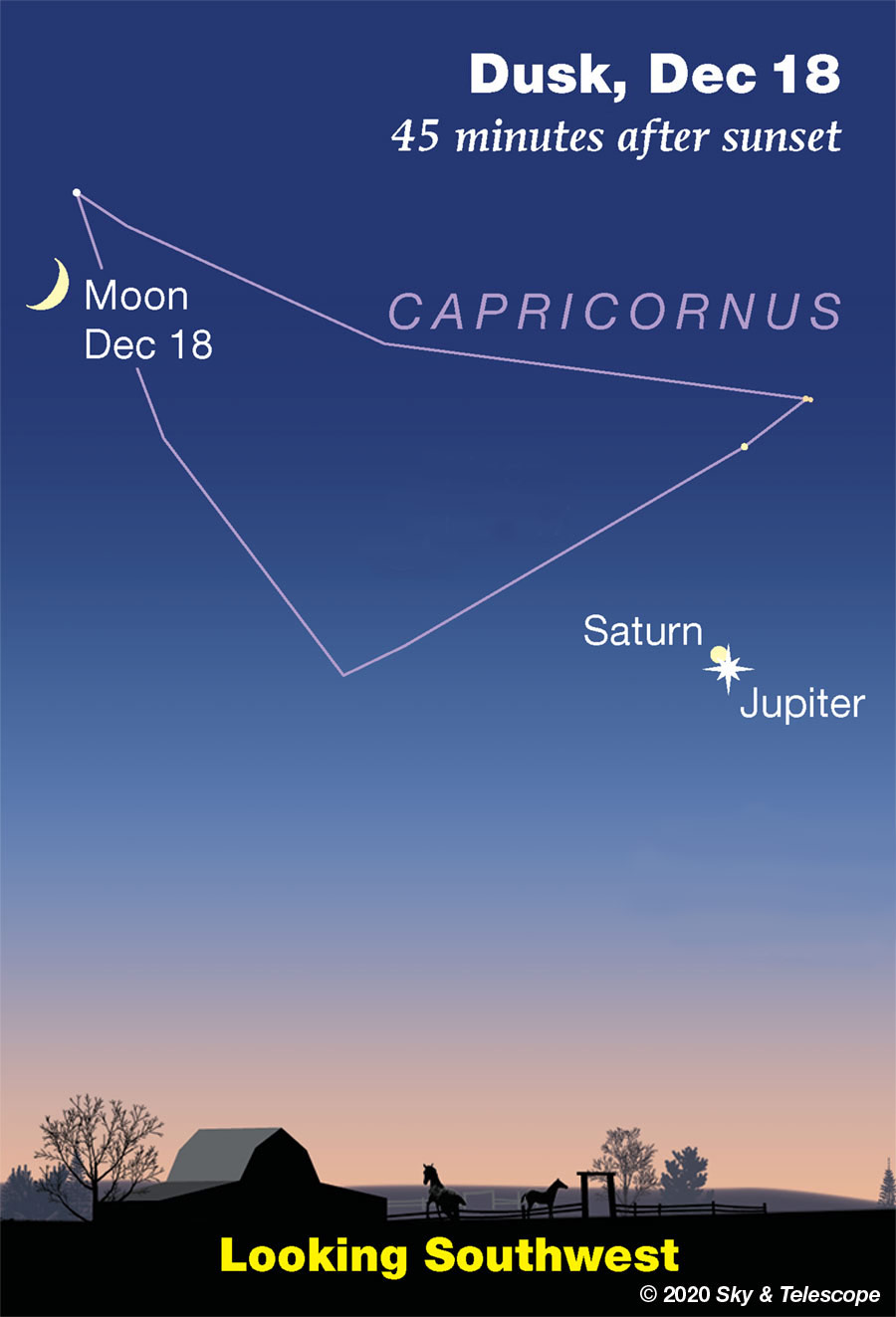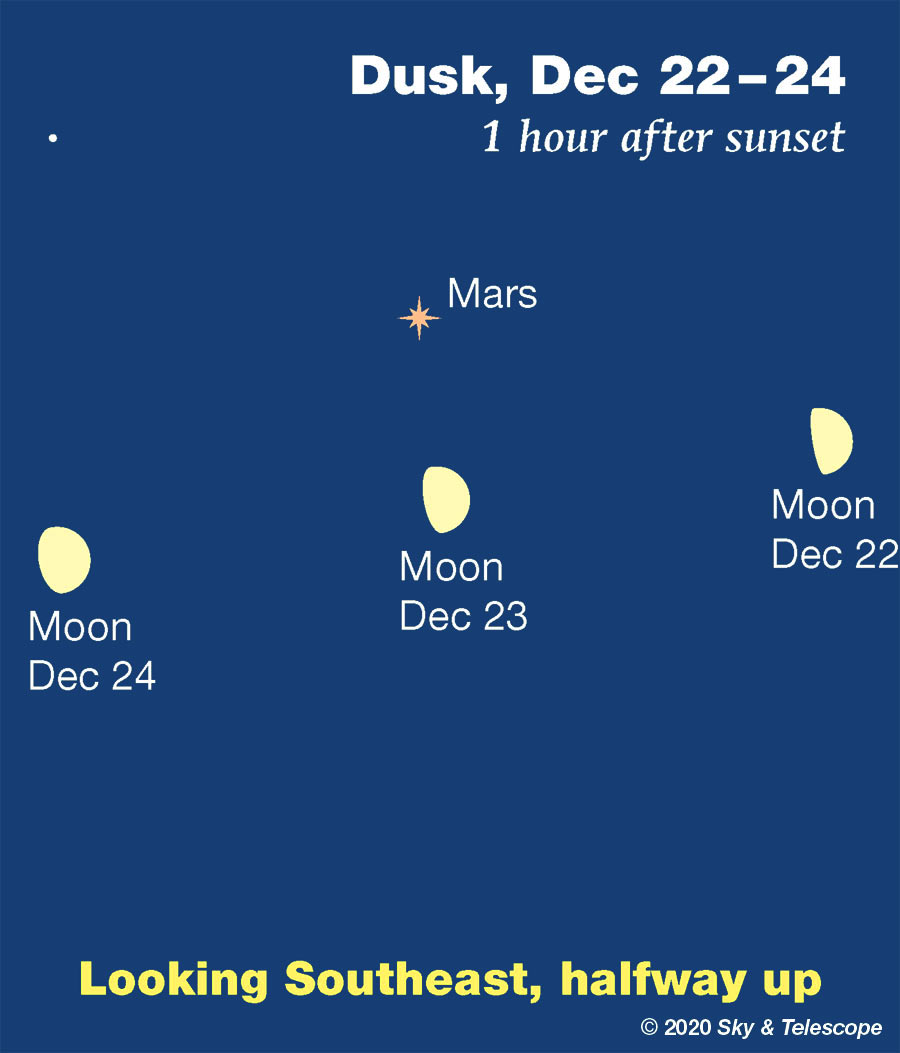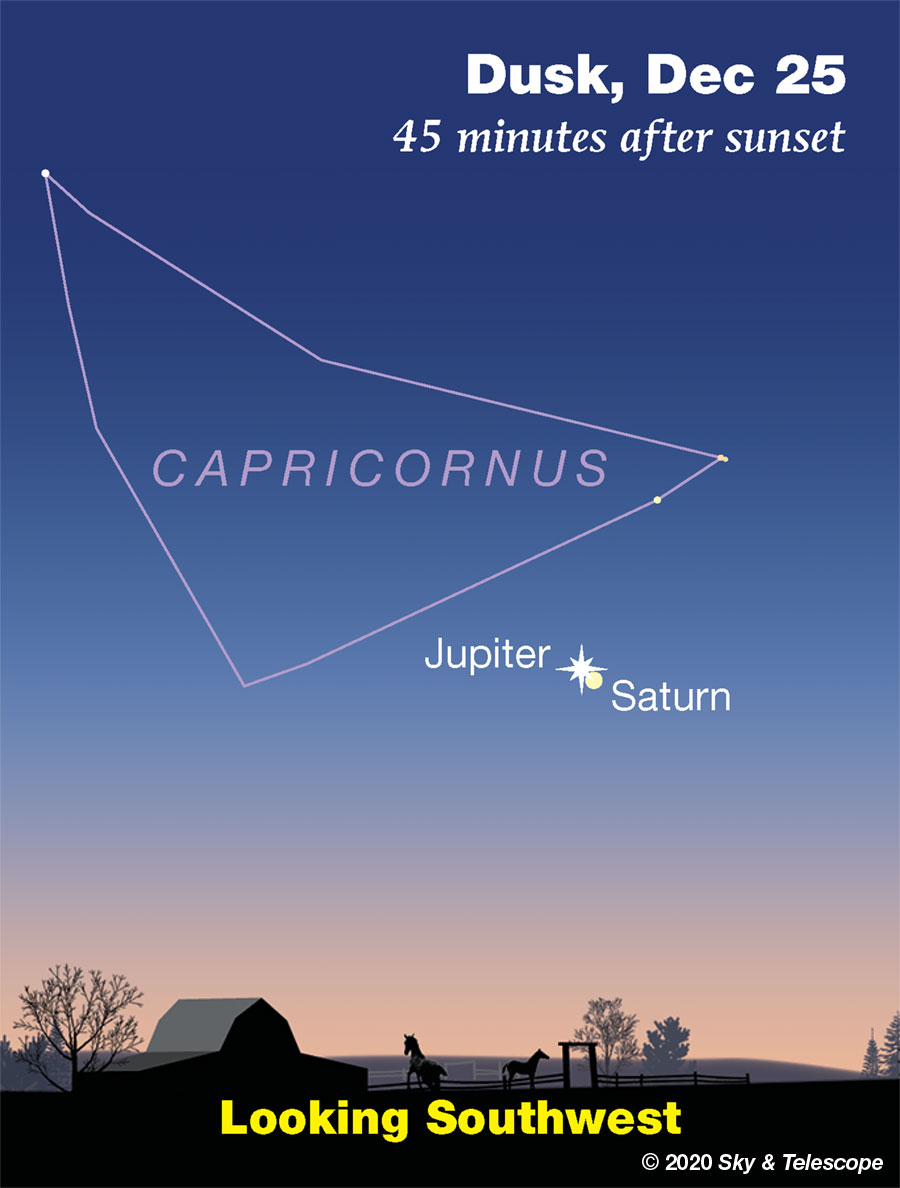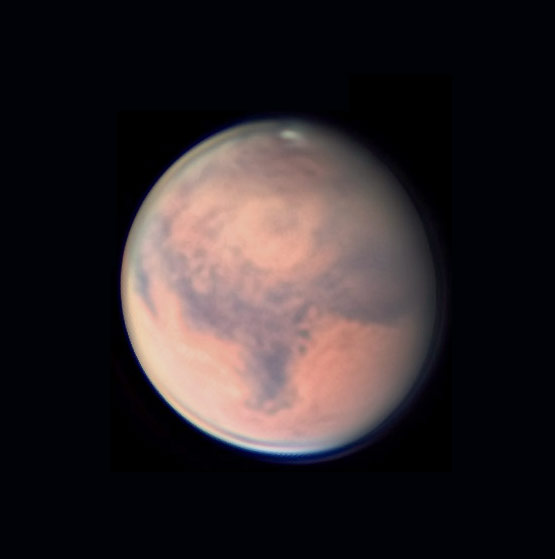FRIDAY, DECEMBER 18
■ Jupiter and Saturn are drawing the world's attention as they creep strikingly closer together in the southwest at nightfall. This evening Saturn is only 0.3° above Jupiter, as shown below in twilight. That's hardly the width of a chopstick at arm's length. They're closing toward a mere 0.1° apart on December 21st, toothpick width! After that they widen again.

All week they'll fit together in the view of most telescope eyepieces at 100 power or less. Around the 21st you could boost the power about as high as you want and they'll still both be in the view, but the atmospheric seeing will be poor at their low altitude, so maybe max out at 150x. Use your scope early in twilight, as early as you can pick out the planet pair. The later you look the lower they'll be.
For lots more info and cool graphics, see Bob King's Jupiter and Saturn Embrace in Solstice Conjunction.
■ Have you ever watched a Sirius-rise? Find an open view down to the east-southeast horizon, and watch for Sirius to come up about two fists at arm's length down where Orion's Belt points to. Sirius rises around 8 p.m. depending on your location.
About 15 minutes before Sirius-rise, a lesser star comes up barely to the right of there. This is Beta Canis Majoris or Mirzam, a name that means “The Announcer.” What Mirzam announces is Sirius. You’re not likely to mistake them; the second-magnitude Announcer is only a twentieth as bright as the king of stars soon to make its royal entry.
When a star is very low it tends to twinkle slowly, and often in vivid colors. Sirius is bright enough to show these effects well, especially in binoculars.
SATURDAY, DECEMBER 19
■ Sirius and Procyon in the balance. Sirius, the Dog Star, sparkles low in the east-southeast after dinnertime. Procyon, the Little Dog Star, shines in the east about two fist-widths at arm's length to Sirius's left.
But directly left? That depends! If you live around latitude 30° (Tijuana, New Orleans, Jacksonville), the two canine stars will be at the same height above your horizon soon after they rise. If you're north of that latitude, Procyon will be higher. If you're south of there, Sirius will be the higher one. Your eastern horizon tilts differently with respect to the stars depending on your latitude.
SUNDAY, DECEMBER 20
■ This is solstice night, the longest night of the year, and tomorrow is the shortest day. The exact time of the solstice is 5:02 a.m. EST Dec. 21. This is when the Sun reaches its farthest point south in the sky and begins its six-month return northward. That's the moment when winter officially begins (in the Northern Hemisphere).
■ You are remembered, Carl Sagan (November 9, 1934 – December 20, 1996).
MONDAY, DECEMBER 21
■ Shortest day of the year; see above.
■ At last, the record-breaking Jupiter-Saturn conjunction is this evening! If you have a telescope, get it on the pair of planets as early in twilight as you can find them, while they're still relatively high. See Jupiter and Saturn Embrace in Solstice Conjunction. (It's just a coincidence that this is happening on the day of the solstice.) And for more background, The 400-Year Rhythm of Great Conjunctions.
■ First-quarter Moon. The Moon is exactly first quarter at 6:41 p.m. EST, while it's in view across North America. The Moon shines under the Great Square of Pegasus. In early evening the Moon forms a big, narrow triangle with Beta Ceti to its lower left and brighter Fomalhaut about twice as far to their lower right.
■ If you're really patient about watching for meteors, tonight should be the peak of December's "other" meteor shower, the Ursids (after the richer Geminids last week). Under a good dark sky you might count a half dozen meteors per hour in the hours before tomorrow's dawn. The shower's radiant (perspective point of origin ) is close to Kochab in Ursa Minor, the Little Dipper, so the radiant is up all night and therefore the shower is somewhat active all night. But meteors will be fewer in the evening when the radiant is lower than it is later, and moonlight will interfere a bit until moonset around midnight.
TUESDAY, DECEMBER 22
■ This evening the Moon shines lower right of Mars, as shown below. As evening advances, the line they form tilts more steeply downward. The Moon sets around 1 a.m., Mars nearly an hour later (for mid-northern latitudes).

WEDNESDAY, DECEMBER 23
■ The waxing gibbous Moon shines high in the evening sky with orange Mars about 6° over it, as shown above.
THURSDAY, DECEMBER 24
■ A Christmas star-tower: This is the time of year when Orion shines in the east-southeast after dinnertime. He's well up now, but his three-star Belt is still nearly vertical. The Belt points up toward Aldebaran and, even higher, the Pleiades.
Off to the right of the Pleiades the Moon shines brightly. Orange Mars glows to the right of the Moon.
FRIDAY, DECEMBER 25

■ As Jupiter and Saturn move apart, they're sinking quite low in the southwest in twilight as shown above.
■ Algol shines at its minimum brightness, magnitude 3.4 instead of its usual 2.1, for a couple hours centered on 12:27 a.m. EST tonight; 9:27 p.m. PST. Algol takes several additional hours to fade and to rebrighten.
SATURDAY, DECEMBER 26
■ The waxing gibbous Moon shines roughly between Aldebaran and the Pleiades. Off to their left sparkles bright Capella.
This Week's Planet Roundup
Mercury is out of sight in conjunction with the Sun.
Venus (magnitude –3.9, at the head of Scorpius) shines low in the southeast during early dawn as the "Morning Star." As dawn advances, watch it climb higher as it fades into the growing daylight.
Mars (about magnitude –0.5, in Pisces) shines bright yellow-orange very high in the south during early evening. Mars is fading and shrinking into the distance, but it's still 12 or 11 arcseconds wide in a telescope, still big enough to show some surface detail during steady seeing. It's gibbous: 90% sunlit from Earth's point of view. Its recent dust storms seem to be over.

To get a map of the side of Mars facing you at the date and time you observe, you can use our Mars Profiler. The map there is square; remember to mentally wrap it onto the side of a globe. (Features near the map's edges become very foreshortened.)
Jupiter and Saturn (magnitudes –2.0 and +0.6, respectively) shine historically close together in the southwest during and after twilight this week. Jupiter is the bright one; Saturn is only about a tenth as bright. Their separation shrinks from 0.3° on December 18th to 0.1° at conjunction on the 21st, then widens to 0.5° by the 25th. This means they'll fit together in many telescopes' low-power view all week. Just don't expect to see much of any telescopic detail on the two planets, due to the poor atmospheric seeing at their low altitude.
For lots more info and graphics, see Jupiter and Saturn Embrace in Solstice Conjunction and The 400-Year Rhythm of Great Conjunctions. The two giants have conjunctions about every 20 years, but this will be their closest in 400 years, and the closest that's been clearly visible (not too close to the Sun) in nearly 800.
Uranus (magnitude 5.7, in Aries) is high in the south-southeast after dark, about 13° east (left) of Mars. Uranus is only 3.7 arcseconds wide, but that's enough to appear as a tiny fuzzy ball, not a point, at high power in even a smallish telescope with sharp optics — during spells of good seeing.
Neptune (magnitude 7.9, in Aquarius) is lower in the south-southwest right after dark. Neptune is 2.3 arcseconds wide, harder to resolve than Uranus except in very good seeing. Finder charts for Uranus and Neptune.
All descriptions that relate to your horizon — including the words up, down, right, and left — are written for the world's mid-northern latitudes. Descriptions that also depend on longitude (mainly Moon positions) are for North America.
Eastern Standard Time, EST, is Universal Time minus 5 hours. (Universal Time is also known as UT, UTC, GMT, or Z time.)
Want to become a better astronomer? Learn your way around the constellations. They're the key to locating everything fainter and deeper to hunt with binoculars or a telescope.
This is an outdoor nature hobby. For an easy-to-use constellation guide covering the whole evening sky, use the big monthly map in the center of each issue of Sky & Telescope, the essential magazine of astronomy.
Once you get a telescope, to put it to good use you'll need a detailed, large-scale sky atlas (set of charts). The basic standard is the Pocket Sky Atlas (in either the original or Jumbo Edition), which shows stars to magnitude 7.6.

Next up is the larger and deeper Sky Atlas 2000.0, plotting stars to magnitude 8.5; nearly three times as many. The next up, once you know your way around, are the even larger Interstellarum atlas (stars to magnitude 9.5) or Uranometria 2000.0 (stars to magnitude 9.75). And be sure to read how to use sky charts with a telescope.
You'll also want a good deep-sky guidebook, such as Sky Atlas 2000.0 Companion by Strong and Sinnott, or the bigger (and illustrated) Night Sky Observer's Guide by Kepple and Sanner.
Can a computerized telescope replace charts? Not for beginners, I don't think, and not on mounts and tripods that are less than top-quality mechanically, meaning heavy and expensive. And as Terence Dickinson and Alan Dyer say in their Backyard Astronomer's Guide, "A full appreciation of the universe cannot come without developing the skills to find things in the sky and understanding how the sky works. This knowledge comes only by spending time under the stars with star maps in hand."
![]() Audio sky tour. Out under the evening sky with your
Audio sky tour. Out under the evening sky with your
earbuds in place, listen to Kelly Beatty's monthly
podcast tour of the heavens above. It's free.
"The dangers of not thinking clearly are much greater now than ever before. It's not that there's something new in our way of thinking, it's that credulous and confused thinking can be much more lethal in ways it was never before."
— Carl Sagan, 1996
"Facts are stubborn things."
— John Adams, 1770
*Answer to why the Moon has a younger (slimmer) phase each month now when it passes Mars:
The seasonal turning of sky carries Mars westward month by month, closer toward our line of sight to the Sun (despite Mars's slower eastward motion against the stars). The closer the Moon is to our line of sight to the Sun, the thinner its phase.
 8
8








Comments
mary beth
December 18, 2020 at 2:56 pm
Merry Christmas Week to all! Hope everyone has the gift of health, joy and CLEAR SKIES!
You must be logged in to post a comment.
Rod
December 19, 2020 at 5:09 pm
mary beth, same to you. Looks like for me I will not be able to see the really, really close conjunction on 21-Dec but skies look much better for me on 22-Dec evening. Saturn and Jupiter about 10 arcminute apart then according to Starry Night Pro Plus 8 simulation view. Both will fit into a 0.5 degree telescope view, no problem so I can see at 130x or more. I posted notes at Bob King report too,https://skyandtelescope.org/astronomy-news/jupiter-and-saturn-embrace-in-solstice-conjunction/
You must be logged in to post a comment.
mary beth
December 19, 2020 at 10:11 pm
Truly Rod - if I could magically switch weather with you, I would give you our (predicted) clear skies because you have such a zest and appreciation for this special occurrence. I read your report on Bob King’s page and everything you said was fascinating. I too believe that Jesus was born in late September. Sure wish we could figure out what the Star of Bethlehem really was! This is a nice article about it:
http://classicalastronomy.com/2020/12/what-was-the-star-of-bethlehem/
You must be logged in to post a comment.
TenOfSwords
December 19, 2020 at 2:49 pm
Shouldn't the heliacal rising of Antares have been included in this edition - especially since Venus is going to pass directly north of Antares during the period covered therein?
You must be logged in to post a comment.
Rod
December 21, 2020 at 7:02 pm
mary beth et al. I did enjoy some telescope and binocular observations of the Christmas star tonight after sunset, skies cleared up, mostly shortly after sunset. See the updated report here, https://skyandtelescope.org/astronomy-news/jupiter-and-saturn-embrace-in-solstice-conjunction/#comment-265354
In short summary - this was a great celestial event to see!
You must be logged in to post a comment.
mary beth
December 21, 2020 at 8:32 pm
Oh that’s great news! I’m really happy to hear you ended up getting some clear skies right in time! I just read your full report and it sounds like it was a beautiful view with the telescope! Clear skies here as well and looked beautiful with just my eyes. Hopefully New Jersey Eclipse Fan was able to see it as well...Maybe he will report.. very nice ending to a crazy year!
You must be logged in to post a comment.
New Jersey Eclipse Fan
December 23, 2020 at 5:29 pm
I did view the conjunction last night, and commented on the stream from the other article. It was weird seeing Saturn to the right (East?) of Jupiter when it's been to the left (West?) for these past few months.
You must be logged in to post a comment.
mary beth
December 24, 2020 at 12:36 pm
Happy Holidays! Wonderful that you got to see the conjunction! I agree I was very surprised or Saturn was, at the 1 o’clock position... what an amazing procession of the stars and planets!
You must be logged in to post a comment.
You must be logged in to post a comment.